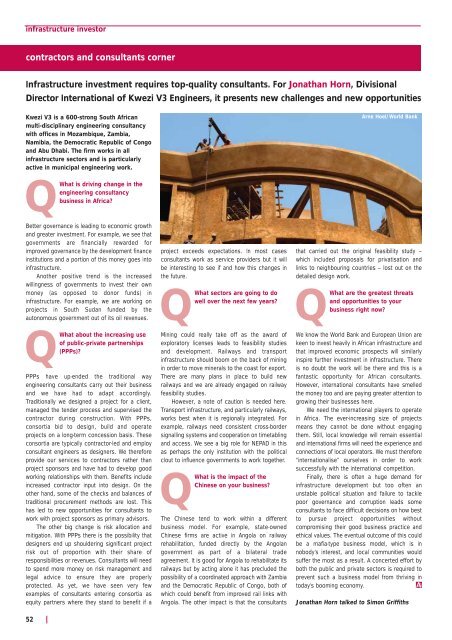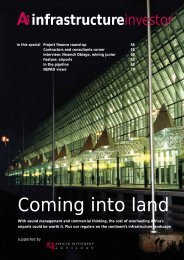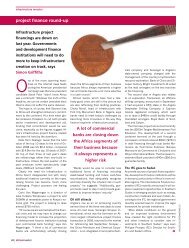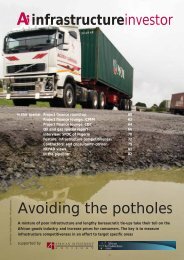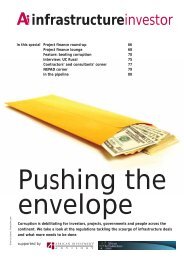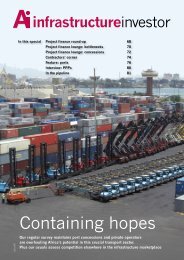Infrastructure investor March 200 - Simon Griffiths
Infrastructure investor March 200 - Simon Griffiths
Infrastructure investor March 200 - Simon Griffiths
Create successful ePaper yourself
Turn your PDF publications into a flip-book with our unique Google optimized e-Paper software.
infrastructure <strong>investor</strong>contractors and consultants corner<strong>Infrastructure</strong> investment requires top-quality consultants. For Jonathan Horn, DivisionalDirector International of Kwezi V3 Engineers, it presents new challenges and new opportunitiesKwezi V3 is a 600-strong South Africanmulti-disciplinary engineering consultancywith offices in Mozambique, Zambia,Namibia, the Democratic Republic of Congoand Abu Dhabi. The firm works in allinfrastructure sectors and is particularlyactive in municipal engineering work.Arne Hoel/World BankQWhat is driving change in theengineering consultancybusiness in Africa?Better governance is leading to economic growthand greater investment. For example, we see thatgovernments are financially rewarded forimproved governance by the development financeinstitutions and a portion of this money goes intoinfrastructure.Another positive trend is the increasedwillingness of governments to invest their ownmoney (as opposed to donor funds) ininfrastructure. For example, we are working onprojects in South Sudan funded by theautonomous government out of its oil revenues.QWhat about the increasing useof public-private partnerships(PPPs)?PPPs have up-ended the traditional wayengineering consultants carry out their businessand we have had to adapt accordingly.Traditionally we designed a project for a client,managed the tender process and supervised thecontractor during construction. With PPPs,consortia bid to design, build and operateprojects on a long-term concession basis. Theseconsortia are typically contractor-led and employconsultant engineers as designers. We thereforeprovide our services to contractors rather thanproject sponsors and have had to develop goodworking relationships with them. Benefits includeincreased contractor input into design. On theother hand, some of the checks and balances oftraditional procurement methods are lost. Thishas led to new opportunities for consultants towork with project sponsors as primary advisors.The other big change is risk allocation andmitigation. With PPPs there is the possibility thatdesigners end up shouldering significant projectrisk out of proportion with their share ofresponsibilities or revenues. Consultants will needto spend more money on risk management andlegal advice to ensure they are properlyprotected. As yet, we have seen very fewexamples of consultants entering consortia asequity partners where they stand to benefit if aproject exceeds expectations. In most casesconsultants work as service providers but it willbe interesting to see if and how this changes inthe future.QWhat sectors are going to dowell over the next few years?Mining could really take off as the award ofexploratory licenses leads to feasibility studiesand development. Railways and transportinfrastructure should boom on the back of miningin order to move minerals to the coast for export.There are many plans in place to build newrailways and we are already engaged on railwayfeasibility studies.However, a note of caution is needed here.Transport infrastructure, and particularly railways,works best when it is regionally integrated. Forexample, railways need consistent cross-bordersignalling systems and cooperation on timetablingand access. We see a big role for NEPAD in thisas perhaps the only institution with the politicalclout to influence governments to work together.QWhat is the impact of theChinese on your business?The Chinese tend to work within a differentbusiness model. For example, state-ownedChinese firms are active in Angola on railwayrehabilitation, funded directly by the Angolangovernment as part of a bilateral tradeagreement. It is good for Angola to rehabilitate itsrailways but by acting alone it has precluded thepossibility of a coordinated approach with Zambiaand the Democratic Republic of Congo, both ofwhich could benefit from improved rail links withAngola. The other impact is that the consultantsthat carried out the original feasibility study –which included proposals for privatisation andlinks to neighbouring countries – lost out on thedetailed design work.QWhat are the greatest threatsand opportunities to yourbusiness right now?We know the World Bank and European Union arekeen to invest heavily in African infrastructure andthat improved economic prospects will similarlyinspire further investment in infrastructure. Thereis no doubt the work will be there and this is afantastic opportunity for African consultants.However, international consultants have smelledthe money too and are paying greater attention togrowing their businesses here.We need the international players to operatein Africa. The ever-increasing size of projectsmeans they cannot be done without engagingthem. Still, local knowledge will remain essentialand international firms will need the experience andconnections of local operators. We must therefore“internationalise” ourselves in order to worksuccessfully with the international competition.Finally, there is often a huge demand forinfrastructure development but too often anunstable political situation and failure to tacklepoor governance and corruption leads someconsultants to face difficult decisions on how bestto pursue project opportunities withoutcompromising their good business practice andethical values. The eventual outcome of this couldbe a mafia-type business model, which is innobody’s interest, and local communities wouldsuffer the most as a result. A concerted effort byboth the public and private sectors is required toprevent such a business model from thriving intoday’s booming economy.Jonathan Horn talked to <strong>Simon</strong> <strong>Griffiths</strong>52


